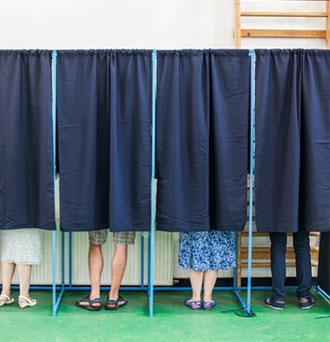
It’s been a difficult 15 months if you care about the environment. Since President Donald Trump’s inauguration, he’s made fracking easier on public lands, decimated the Environmental Protection Agency and renounced the Paris climate accord.
These are just a few reasons millions of Americans will pledge their support for the environment on April 22 for Earth Day.
But this year, that is not enough. This year, if you care about the environment, you should spend April 22 and every other day working toward a more important date ― Nov. 6, Election Day. That’s when we can force policymakers to protect our climate and natural resources. Nov. 6 is this year’s Earth Day, and all of us need to show up.
Unfortunately, we haven’t always shown up in the past. According to Environmental Voter Project research, 69 percent of registered voters cast votes in 2016, but only 50 percent of environmentalists did. In the 2014 midterms, 44 percent of registered voters went to the polls, compared with only 21 percent of environmentalists.
Simply put, the environmental movement has a turnout problem, but this problem also presents an enormous opportunity. By some estimates, over 20 million registered voters list climate change and the environment among their top priorities. This could be a powerful constituency on Election Day, particularly in midterm elections where barely 80 million people vote. Nonvoters are the low-hanging fruit of the climate movement. They are already-persuaded environmentalists in a society where it’s increasingly hard to persuade anybody of anything.
Over the past few years, behavioral scientists have come to bemoan the difficulty of political persuasion in a “post-truth” world, and they reference our growing tendency to evaluate information based not on conformity with common societal standards (like evidence or logic), but simply on whether it supports the values of our “tribe” (i.e., what is good for our team equals the truth).
Unfortunately, political persuasion is even more difficult when we discuss climate change. In this context, recent studies have even documented a phenomenon called the “backfire effect,” which reveals that confronting climate-deniers with facts and science often doesn’t persuade them of anything, but rather causes them to cling to their wrong views even more tenaciously than before.
In short, it is extraordinarily hard to persuade people to start caring about climate change, so it’s all the more important for those of us who already care to vote.
The good news is this: We have overwhelming numbers of voters who value environmental issues. And if we vote, politicians will follow ― we need only look back to the first Earth Day for proof.
On April 22, 1970, 20 million Americans took to the streets, protesting smog-choked air and toxic water in the largest demonstration in American history.
At the time, this took much of the nation by surprise. Neither Richard Nixon nor Hubert Humphrey had focused on environmental issues in the 1968 presidential campaign. And in May of 1969, only 1 percent of Americans named “pollution/ecology” as one of the country’s most important problems. Yet by 1971, that number had soared to 25 percent.
Even back then, politicians knew how to read polls and respond accordingly.
With astonishing speed, Nixon worked with Congress to form the Environmental Protection Agency, and then enact the Clean Air Act, the Clean Water Act and the Lead-Based Paint Poisoning Prevention Act, all before a single ballot was cast in the 1972 election.
2018 is looking eerily similar to 1970. The effects of climate change are being felt like never before, and millions of registered voters count the environment as a priority. Yet, one thing is strikingly different: Politicians aren’t responding like they did in the 1970s. Climate change wasn’t mentioned once in the State of the Union address, nor in the Democratic response. And no more than a handful of candidates are mentioning environmental issues on the stump.
Why the change? Politicians certainly still care about getting elected, but now they have a secret weapon: Now they know which people are going to vote on Election Day and which people are going to stay home. And, recently, environmentalists have been staying at home, which makes them easy to ignore.
Since the early 2000s, campaigns have been able to search each citizen’s voting history on easy-to-access voter file software from companies like NGP VAN or the GOP Data Center. Don’t worry: Whom you vote for is secret, but which elections you vote in is public information. For obvious reasons, these public voting histories are now the lifeblood of modern campaigns, allowing candidates to focus their limited resources on polling and communicating with only those people who are likely to show up on Election Day.
This means that politicians now only care about the policy priorities of voters, not nonvoters. This shouldn’t surprise us: We wouldn’t expect Starbucks to care about people who don’t drink coffee, so why would campaigns care about people who don’t vote? And, unfortunately, environmentalists aren’t voting.
But this is not a reason for despair; it is a reason for hope. In a world of big, scary problems like climate change, altering our voting habits is actually a pretty easy problem to fix. It takes the average American only 14 minutes to vote, and it can have an enormous effect.
So this Earth Day, circle Nov. 6 on your calendar and pledge to vote. If we choose to, environmentalists could overwhelm the electorate. And, yes, politicians will take notice because nothing motivates a politician more than the prospect of winning ― or losing ― an election.
Nathaniel Stinnett is the executive director of the Environmental Voter Project, a nonpartisan nonprofit that uses data analytics and behavioral science to get environmentalists to vote.
